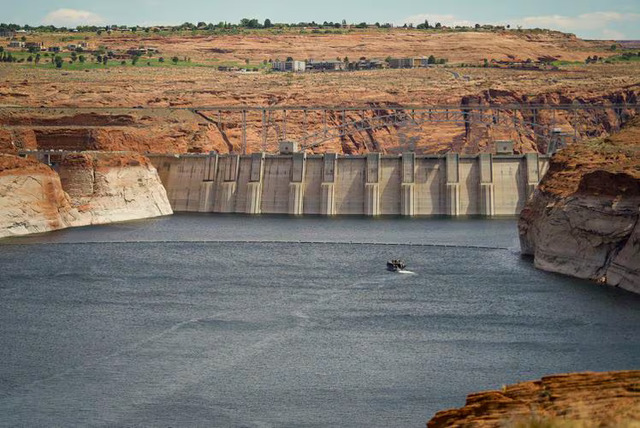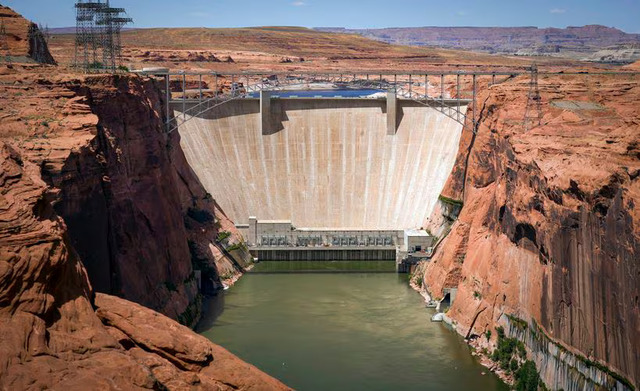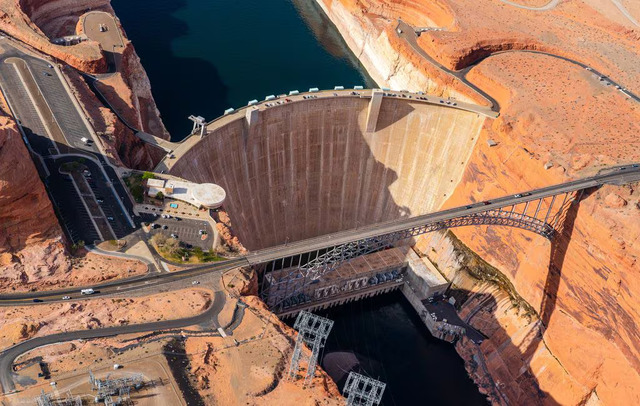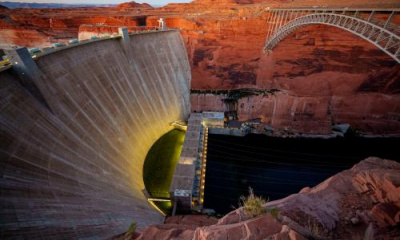Recently discovered issues could affect how Upper Basin states deliver water to Lower Basin states.
Glen Canyon Dam, which creates the second-largest reservoir in the U.S., enables the distribution of Colorado River water throughout the West and generates power for seven states.
It also has a plumbing problem.
Federal officials recently identified damage within Glen Canyon Dam, which creates Lake Powell on the Arizona-Utah border. According to the Bureau of Reclamation, a federal agency that owns and operates dams across the country, four 8-foot-wide steel pipes called the river outlet works have suffered from cavitation — a process that can erode and thin pipes.
The river outlet works were originally intended to release water from Lake Powell when the reservoir was flooding, which hasn’t happened since 1987.
Lake Powell hit a record-low elevation in Feb. 2023, but after a record-setting winter later that year, the reservoir has rebounded — though it is still less than a third of the way full. If dry conditions and overuse persist and the reservoir’s level falls below 3,490 feet above sea level, the pipes would be the only means of delivering water to Arizona, Nevada and California — the Lower Colorado River Basin states. That key elevation is the minimum elevation for hydropower production at the dam, also called “minimum power pool,” and lies below the usual release pipes.
Due to the damage in the river outlet works, the pipes can’t handle high water flows, meaning that Reclamation must send less water downstream through the pipes at low reservoir elevations. That would jeopardize the laws governing Colorado River use, which mandate that the Upper Colorado River Basin states above Lake Powell — Colorado, New Mexico, Utah and Wyoming — deliver a certain amount of water to the Lower Basin states each year.
“The archaic plumbing inside…Glen Canyon Dam is the most urgent water problem facing the 40 million people of the Colorado River Basin,” said Zach Frankel, executive director of the nonprofit Utah Rivers Council.
The reservoir and the dam operations aren’t yet in dire straits. Reclamation projections forecast that Lake Powell won’t dip below 3,490 feet through Feb. 2026, and the agency says it’s working on methods to deliver water downstream at elevations below minimum power pool.
The thinning of Glen Canyon Dam’s river outlet works and resulting water delivery uncertainty at low lake elevations reveal longer-term problems and the need for permanent solutions.
According to Amy Haas, executive director of the Colorado River Authority of Utah, cavitation in Glen Canyon Dam exposes years of mismanagement throughout the whole Colorado River Basin, compounded by higher temperatures and declining flows.
“We need to look back and realize how we got here, which is because use has exceeded the available supply in this basin,” she said. “If we could get that under control, that would go a long way.”
A closer look at the damage

(Bethany Baker | The Salt Lake Tribune) A boat travels near Glen Canyon Dam near Page, Ariz. on Thursday, July 13, 2023.
Water from mountain snowmelt in the Upper Basin states flows into the Colorado River, eventually pooling behind Glen Canyon Dam in Lake Powell. Reclamation releases water downstream through the Grand Canyon to Lake Mead.
When Lake Powell is at full capacity, Glen Canyon Dam impounds over 25 million acre-feet of water. One acre-foot of water can sustain two households for one year.
But the reservoir’s elevations have taken a nosedive in the 21st century. It is currently about 32% full, or 3,559 feet above sea level.
Reclamation reports that the agency can “theoretically” release water from Glen Canyon Dam through the river outlet works down to 3,370 feet, an elevation referred to as “dead pool.” At that elevation, 120 feet below the critical hydropower-producing elevation of 3,490 feet, water can no longer flow through the dam with gravity.
The damage found at Glen Canyon Dam, first reported by the Arizona Daily Star, is due to water changing into water vapor bubbles and then back to liquid, a process called cavitation that occurs when water travels through the pipes at high velocities. The bubbles bursting against the river outlet works create high pressures that have eroded the pipes over time.
As a result, Reclamation recently determined that the agency can only safely send water through the river outlet works at 24 feet above dead pool.
That means that the elevation at which the Upper Basin states breach their obligation to send water to the Lower Basin states could happen sooner. “Once the water level drops below the hydropower intake,” Frankel explained, “the clock starts ticking on the Upper Basin violating its water delivery.”
Keeping power flowing

(Bethany Baker | The Salt Lake Tribune) Glen Canyon Dam stands near Page, Ariz. on Thursday, July 13, 2023.
Reclamation says that it’s considering a “a major overhaul or replacement” of the four steel pipes in the river outlet works to ensure water delivery if water can’t be released any other way, according to a 2023 special inspection.
That kind of engineering takes time and money. In the meantime, Reclamation reports that its priority is maintaining Lake Powell’s elevation above minimum power pool. Achieving that goal could affect each basin in different ways.
If Lake Powell reaches critical levels again, Reclamation could direct the Upper Basin to release water from its upstream reservoirs — like Flaming Gorge in Wyoming and Blue Mesa in Colorado — to shore up Lake Powell. That last happened in May 2022, when Reclamation released 500,000 acre-feet of water from Flaming Gorge to boost Lake Powell. Colorado, New Mexico, Utah and Wyoming might also need to reduce use so more water can reach the reservoir.
In an email, Reclamation said that current agreements dictate that the agency should not consider those releases until Lake Powell’s elevation drops below 3,525 feet above sea level.
The Lower Basin states might also have to work with less water if Lake Powell continues to shrink. Keeping more water behind Glen Canyon Dam could mean that Reclamation would release less water downstream, forcing Arizona, Nevada and California to reduce use.
As far as engineering solutions go, environmentalists advocate for the construction of bypass tubes, which are tunnels around the dam to let water out if Lake Powell’s elevations sink below the river outlet works.
“It’s not if, but when,” said Frankel, with the Utah Rivers Council. “The likelihood that Lake Powell reaches dead pool is all but guaranteed. Implementing bypass tubes at riverbed level doesn’t mean you’re never going to be able to raise the reservoir again. It just gives you flexibility.”
But a bypass solution could threaten Glen Canyon Dam’s hydropower production. Beyond water delivery, eight generators within the 710-foot dam produce about 5 billion kilowatt-hours of hydroelectricity each year, distributed to Arizona, Colorado, Nebraska, Nevada, New Mexico, Utah and Wyoming. The average home uses 10,000 kilowatt-hours each year.
Reclamation wrote in an email that the agency is considering other engineering solutions and mitigation strategies to avoid relying on the river outlet works for water delivery long-term.
How this impacts negotiations between the states

(Ecoflight) An aerial view of the Glen Canyon Dam at Lake Powell, Thursday, April 14, 2022.
The Colorado River has been overused and drought-ridden for years. The seven states that rely on the river are in the midst of negotiations to decide how to operate the river and its reservoirs after 2026, when current agreements expire, a process that will impact the 40 million Americans and 30 Native American tribes who depend on the water.
Their biggest issue, given declining flows and overuse: which states should have to cut their water use — and by how much?
The damage to Glen Canyon Dam could impact those discussions.
“I do think there will be an intersect between our post-2026 discussions and this issue,” said Haas, with the Colorado River Authority of Utah.
The faulty plumbing within Glen Canyon Dam is a significant problem. But for Haas, this recent discovery implicates the larger crisis behind the need for short-term migration and engineering fixes.
“We have an imbalance between supply and demand,” she said. “If we were to operate the system differently, we wouldn’t be in this situation.”
By operating the system differently, Haas pointed to relying on the actual amount of water available in the Colorado River system — the river itself and its reservoirs — rather than forecasts.
Both the Upper and Lower Basins recognize that need. Both basins submitted competing post-2026 proposals to Reclamation in March, diverging on who should bear the brunt of water cuts if Lake Powell and Lake Mead continue to shrink.
Reclamation has also received proposals from environmental nonprofits and academics. The agency has begun modeling the plans, aiming to complete a draft environmental impact statement for post-2026 operations by the end of 2024.
“To the extent these engineering and mitigation strategies are developed, they will be reflected in the Post-2026 Process as appropriate,” Reclamation wrote in an email about solutions to the damaged river outlet works in Glen Canyon Dam.
“Getting the system in balance post-2026 is going to go a long way to shoring up Lake Powell and Lake Mead elevations if we do it right,” Haas said









